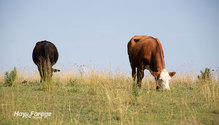
Summer weather is ideal for many activities, such as camping, boating, and having a barbeque; however, hot and dry conditions are not ideal for cool-season grass growth. These species can succumb to the heat and essentially go dormant, also known as the summer slump.
In an article from Penn State Extension, Sjoerd Willem Duinker, professor of soil management and applied soil physics, and Justin Brackenrich and Leanna Duppstadt, extension educators, note that cool-season species prefer temperatures between 60°F and 80°F. If it gets any hotter, forage growth dramatically slows, and pastures are more susceptible to being overgrazed. Therefore, grazing plans must be modified to maintain sufficient plant height this time of year.
Adverse effects
“Aboveground biomass is important to grazing systems because what you see aboveground is reflected belowground,” the specialists state. “Research has shown that if grass is grazed very short repeatedly, the root system dies back significantly, and the stand declines.”
If root systems are weak, weeds can take over. Many pasture weeds have taproots that grow deeper than the fibrous roots of grasses, allowing them to acquire more water and outcompete desirable forages.
Grazing grass too short also accelerates soil erosion and nutrient runoff, and bare soil is subject to excessive heating. “Tillers could be exposed to temperatures as high as 95°F compared to the temperatures in the mid-70°F range under a well-developed canopy,” the authors write. “Those high temperatures could cause tillers to die and result in thin stands.”
Since most grasses store energy reserves in the lower parts of their stems, they must not be grazed below 3 to 4 inches. This ensures plants have enough energy to support a healthy root system and grow new leaves for adequate ground cover. Greater leaf area also enhances photosynthesis, which bolsters energy for future regrowth.
Rotate and feed hay
One way to manage forage height is to implement rotational grazing. “Separate a large pasture into smaller sections with permanent or temporary fencing and rotate animals out when grasses reach that 3- to 4-inch height. They can then be rotated back into an already grazed paddock when forage height reaches 6 to 8 inches or more,” the specialists instruct.
If temperatures continue to rise and dry weather persists, livestock must be removed from cool-season pastures to safeguard forage quality and stand persistence. Consider integrating warm-season species such as millet, sorghum, sorghum-sudangrass, teff, cow pea, switchgrass, and big bluestem into a system and rotating animals through these paddocks instead.
Another option is to feed dry hay. “Bringing animals into a dry lot and feeding hay for a few weeks can allow the grasses to regrow, which will help to increase stand longevity and reduce the need to reseed a stand that has become too thin from overgrazing,” the authors explain.
Hay can also be fed in a sacrifice lot. Dedicate a section of land that is in poor condition as a feeding area and use fences to separate it from the rest of the pasture. Even though the sacrifice lot may experience heavy hoof traffic, the nutrients cycled by animals and imported hay can improve soil health, and these areas can be reseeded in the fall.

Amber Friedrichsen is the 2022 Hay & Forage Grower editorial intern. She currently attends Iowa State University where she is majoring in agriculture and life sciences education-communications and agronomy. Friedrichsen grew up on her family’s diversified crop and livestock farm near Clinton, Iowa.

